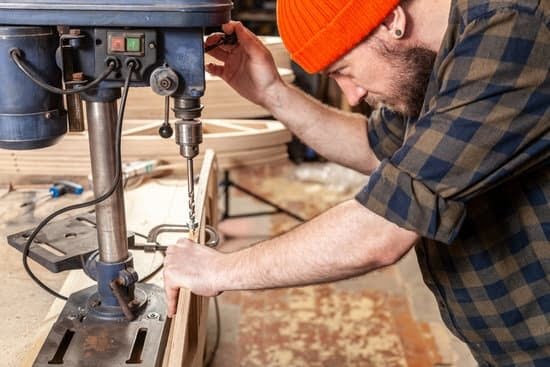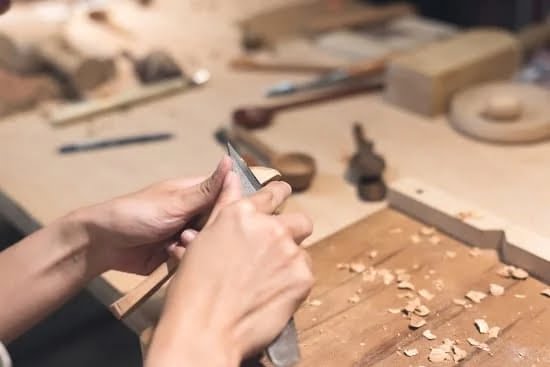Introduction
Woodworking with only hand tools has been around since the beginning of time. From small sculptures to intricate furniture pieces, craftsmen have long relied on their own strength and skill to create beautiful items from natural materials. In recent times the use of hand tools for woodworking has become incredibly popular, especially with enthusiasts in the do-it-yourself and primitive crafting communities. Taking on a project with only your hands and a variety of hand tools can be an incredibly interesting and rewarding experience as it allows you to make use of traditional building methods while also developing skills such as precision carving and inlay work. The challenge of creating something with no powered assistance can also be a source of pride and sense of accomplishment.
This article provides an overview of woodworking with only hand tools; discussing the benefits, types of projects which can created, range of tools needed, safety considerations, and links to additional resources. Utilizing only hand tools requires more effort than using modern machinery but produces results that are often more accurate than power assisted techniques. Knowing both the challenges and rewards comes from understanding how to properly use the various hand tools available for working wooden objects. Read on to learn more about this captivating craft!
Preparing for Woodworking
When it comes to woodworking with only hand tools, the most important part is finding the right work area and gathering the essential tools. Depending on your project, you will need a dedicated workspace that can be cleared of all clutter, which should include enough space for materials, tools, and woodworking benches. Make sure your workspace has adequate light and ventilation to keep dust from accumulating.
As for the essential tools required for woodworking with only hand tools, DIYers will need quality hand saws such as dovetail and cross cut saws; measuring devices like a ruler or square; chisels; clamps; a sharpening stone; and a good-quality hammer. The quality of these tools is critical in order to achieve efficiency and accuracy when creating projects by hand. It’s also important to consider other accessories like protective eyewear and ear protection when working with loud tools such as saws or hammers. Proper safety equipment is necessary to avoid hazards while working with any form of machinery, including manual ones. Finally, proper storage solutions such as tool boxes, drawers, shelves and trays are essential for maintaining organization in order to stay efficient throughout your project.
Crafting Your Woodworking Projects With Hand Tools
Woodworking with hand tools requires an ancient level of skill combined with a modern knowledge of how to use the tools. Traditionally, there were no power tools available to woodworkers which meant working with your hands in order to create functional and beautiful pieces. Nowadays, hand tools are still being used as they offer a unique feel to each project; producing something that is truly unique and individual.
There are a few materials needed if you plan on woodworking with only your hands: quality hand saws such as Japanese pull saws, large secured vices, chisels, and planes. Also, straight edges that are essential for any accurate cutting or jointing. These are all essential pieces of equipment when it comes to crafting any project from start to finish.
Further, sharpening these tools is also important in order for them to perform at optimum levels and yield the highest quality results. Knowing how sharpen each tool properly can take time and practice but it’s well worth the effort to become more efficient and produce high-quality works as a result. Developing an eye for accuracy is key in this art form as eyeballing measurements can be unreliable most of the time.
Understanding wood properties like hardness and grain orientation will help you make informed decisions while crafting any project; you’ll know what type of joints should be used in different situations, how much pressure should be applied while cutting or planing different kinds of wood, etc etc.. Taking into account all these points among others will ensure that projects proceed fairly smoothly without any major problem occurring midway through construction.
Taking Precautions
It is essential to practice proper safety techniques when woodworking with only hand tools. To ensure a safe working environment while protecting yourself from injury, always wear sturdy gloves, eye protection, and hearing protection if necessary. Maintain regular inspections of your work area to ensure sharp edges are hidden or guarded and power lines remain off the ground. Regularly inspect hand tools for signs of damage or wear and discard any that may compromise the integrity of your work. Read all instructional manual for new hand tools before use and keep them nearby for quick refeerence during operation.
When sawing wood with a handsaw, execute smoothe strokes and have a firm grip on the handle to stay in control of your cut. When using chisels or other blades, use light pressure when striking the wood—excess force can cause the blade to slip or drive pieces out unexpectedly. Keep your workspace organized by storing all tools in labeled drawers when not in use and completing one task before starting another so multiple projects are not left unfinished at once. Finally, never leave sharp blades exposed; always place them in a storage box to keep away from curious hands and heads!
Finishing Up
There are a variety of techniques that can be used when finishing up a project using only hand tools in woodworking. For example, sanding is an essential step in order to smooth any rough surfaces and create a clean surface without bumps or tears. Additionally, filling holes from nails or screws is important to ensure an even finish. Wood putty or wood filler can be used in these situations since it can most effectively fill the holes and provide a layer for staining or painting on top of. Furthermore, for projects where paint will be applied, sanding needs to be followed with applying primer which serves as a barrier between the wood and the paint itself. Lastly, for projects calling for natural finishes such as classic oil finishes or wax finishes, various finishing oils applied with the use of steel wool is recommended to create a lasting and rich finish. Ultimately, careful attention to detail when finishing up is what sets apart woodworking projects done by hand from those done by machines creating professional results!
Keep Your Tools in Prime Condition
It is essential to have hand tools that are in the best condition possible to get the most use and enjoyment out of woodworking. It can be time-consuming, but it’s important to take good care of your tools and make sure they are cleaned, oiled, and properly sharpened at all times.
Tools should be cleaned after every use because dirt and sawdust can cause them to wear down faster over time. WD-40 or a similar product is often used to lubricate hand tools so they move freely and don’t bind up while being used. Wiping the tools down with a cloth will help remove any excess oil residue before storage.
Inspecting your tools often is necessary as well. Occasionally check for any chips or signs of damage, such as cracks or bends in blades or shafts. You need to pay particular attention to cutting edges or blade tips, which can become dull quickly if not taken care of properly.
Sharpening your tools regularly is one of the best ways to keep them in prime condition. There are many different methods you can use, from using sharpening stones to using an electric grinder. Whatever technique you choose, it’s important that you sharpen each tool correctly according to its design for optimal results and longevity.
Inspiration
Woodworking projects completed with only hand tools can be quite inspiring. Many people who are starting out in woodworking may still be unfamiliar with power tools and the host of possibilities that come with their use, but examples of projects created by dedicated craftsmen and craftswomen exclusively with hand tools can motivate them to expand upon what they might be able to create.
By looking at photos of furniture, sculptures and wooden items such as spoons, bowls, fish traps and so on that were created only with hand tools, it is possible to get an idea of what one can accomplish without the use of any machines or modern technology. Also, these examples can spark ideas and show techniques that the woodworker would not have thought of before. There are many resources available where these examples can be found – from books about aspects of traditional woodworking and carpentry which feature photographs and descriptions for reference, to communities on websites such as Instagram where fellow woodworkers share progress photos and tips for success.
Additionally, seeing firsthand work done by experienced craftsmen using only hand tools demonstrates the sheer depth to which a reciprocating saw or other powered equipment could never go – making it easier actually to see how some pieces are made, step-by-step – while providing a more detailed understanding of traditional carpentry than many beginner guides will provide. In essence, examining amazing projects achieved solely via hand tools shows what is, in fact, possible when it comes to shaping and sculpting wooden components into intricate pieces – allowing anyone interested in this kind of work an insight into what could be an entire new horizon as far as arts and crafts are concerned.
Wrapping Up
Woodworking with hand tools is a rewarding hobby that can give you a great sense of satisfaction. The lifestyle of working with your hands and creating something with your own skill is incredibly gratifying. You don’t need expensive power tools to make great projects, only basic hand tools. With practice you’ll develop the physical strength, confidence and woodworking knowledge that will allow you to complete unique projects with beautiful results.
The journey doesn’t have to stop at just building furniture or accessories for yourself. Building pieces for others creates a level of pride and joy in yourself knowing someone else will enjoy using what you created for years to come. You never know where the journey of woodworking might take you as it’s truly limitless in what you can make and how far you can develop your skillset. You could even end up running a successful custom woodworking business selling pieces online or locally.
Reaching this level requires dedication, practice and patience – but it’s achievable regardless of where you start! When living the woodworking lifestyle with hand tools there are no limits on what can be accomplished – just an opportunity to hone a craft or offer beautiful masterpieces to the world. The only thing standing between starting today – and completing amazing builds – is taking the first step, setting goals and continuously cultivating your passion project. Before long, it won’t feel like work any more! Every day will be an opportunity to learn new techniques, explore different ideas and build greater accomplishments than those before them. With dedication comes great rewards – so what are you waiting for? Start living the woodworker’s dream today!

Hi everyone! I’m a woodworker and blogger, and this is my woodworking blog. In my blog, I share tips and tricks for woodworkers of all skill levels, as well as project ideas that you can try yourself.





